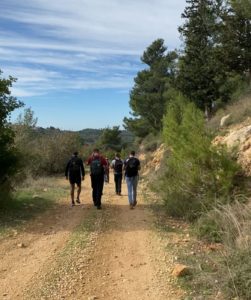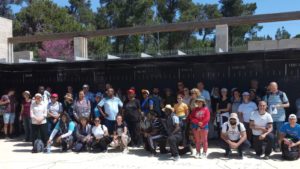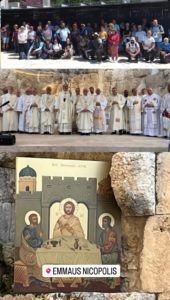There exists a deeply rooted tradition surrounding the events that occurred nearly 2000 years ago, though its current form has only been established for a few years: the Road to Emmaus. On Easter Monday, before dawn, a group of friends and pilgrims from around the world come together. Our meeting point is the Cenacle, right after the Zion Gate in Jerusalem, a stone’s throw from the Abbey of the Dormition.
Here, we place ourselves in the shoes of the disciples on that Sunday morning when the Holy Women returned from visiting Jesus’ tomb. Amidst the tumult and excitement, two disciples, Cleopas, and a companion—who could very well be you or I—decided to leave, their faith shaken by the harsh reality that Jesus was dead and buried. The promised Kingdom of Heaven seemed like a distant dream of the past.
This pilgrimage, organized by the Community of the Beatitudes, follows in the footsteps of those two disciples. For years, pilgrims have undertaken this thirty-two-kilometer journey from the Cenacle in Jerusalem to Emmaus, marking Easter Monday as the annual Emmaus festival. The route connects the Cenacle with a 4th-century basilica in Emmaus Nicopolis, where they gather for Mass, celebrated by the Latin Patriarch of Jerusalem. The “breaking of the bread” in Emmaus, at dusk, marks the culmination of the nine-hour walk, reviving the account from the Gospel of Luke, “quoniam advesperascit”— as evening approached.

On the road to Emmaus Nicopolis 2024
Starting in front of the Cenacle (witness to the departure of the disciples), the trail moves through the Old City of Jerusalem, exiting through the New Gate, the most modern of the seven gates. The pilgrims then proceed along the current Jaffa Street, the artery of the New City of Jerusalem, toward the village of Lifta, the first historical landmark outside the Holy City. Lifta offers a breathtaking view of the region and a tapestry of history.
The journey continues through notable landmarks such as Mevaseret Zion, Abu Gosh (formerly considered the original Emmaus), and Saxum. Passing by the Visitor Center and under the Shrine of Our Lady, Ark of the Covenant, in Kiryat Ye’arim, the pilgrims reach the last uphill slope before entering the valley that leads to the Ayalon Park and culminates in Emmaus Nicopolis.
I have had the opportunity to walk the Road to Emmaus, on Easter Monday, several times. The memory of the conversations along the way, as well as the times of meditation, considering Cleopas and his friend’s discussions with Jesus… on the same path they followed, are hard to explain. I can always return to the Law and the Prophets, starting with Moses, asking the Lord to hear His voice.
This pilgrimage is a physical and spiritual journey that invites deep reflection on loss, hope, faith, and revelation. It is a shared experience that helps to revive the biblical scene, fostering a sense of unity among participants from diverse backgrounds. As we walk the Road to Emmaus, we participate in a tradition that transcends time, connecting us with the disciples’ journey of confusion and joyful recognition. In the end, we rush back to Jerusalem to meet Mary, with our hearts burning.
This year the Saxum Visitor Center served as the midpoint operations center, where pilgrims could rest, pray, eat their picnic, and regain strength; more than 70 people came through there that day. It was a spiritual experience to talk with friends while walking along the road, as Jesus did with Cleopas and his companion. The Mass was celebrated by Cardinal Pierbattista Pizzaballa, followed by a grand feast at the Emmaus Convent.
Joseángel Domínguez

Pilgrims on their way to Emmaus Nicopolis in Saxum Visitor Center 2024

Holy Mass and celebration at Emmaus Nicopolis, 2024
